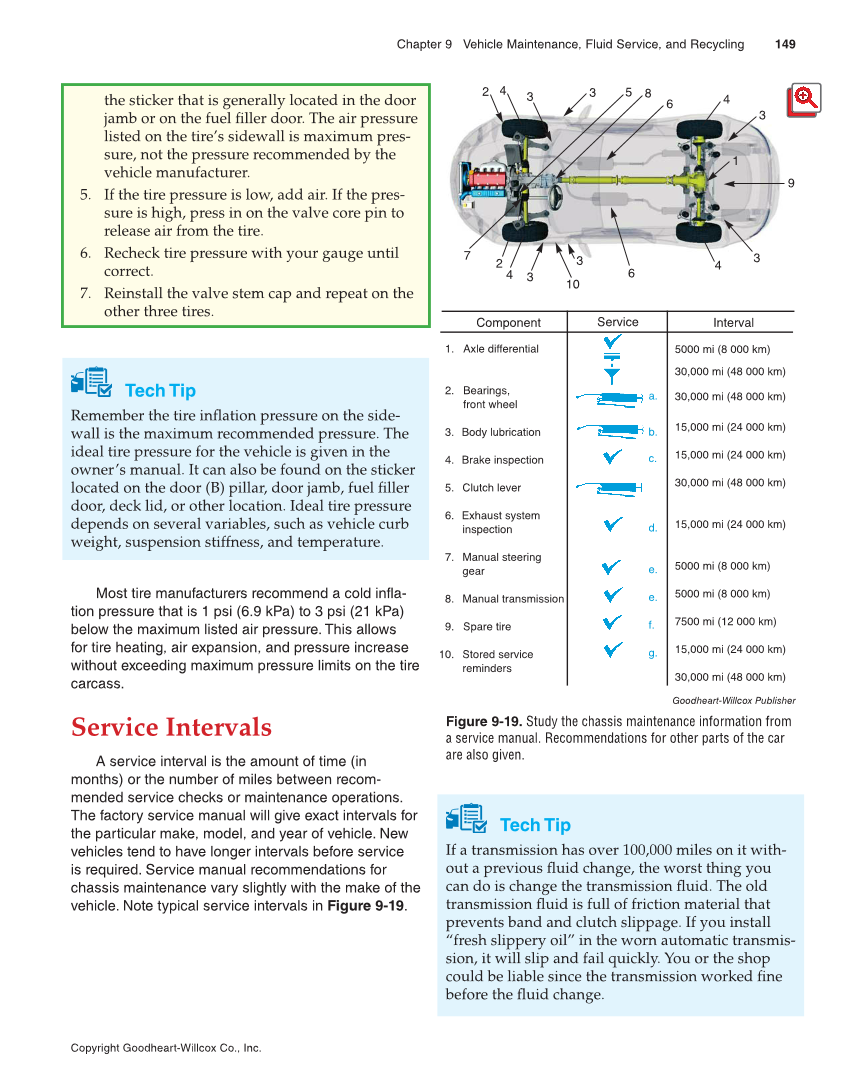Chapter 9 Vehicle Maintenance, Fluid Service, and Recycling 149 Copyright Goodheart-Willcox Co., Inc. the sticker that is generally located in the door jamb or on the fuel filler door. The air pressure listed on the tire’s sidewall is maximum pres- sure, not the pressure recommended by the vehicle manufacturer. 5. If the tire pressure is low, add air. If the pres- sure is high, press in on the valve core pin to release air from the tire. 6. Recheck tire pressure with your gauge until correct. 7. Reinstall the valve stem cap and repeat on the other three tires. Tech Tip Remember the tire inflation pressure on the side- wall is the maximum recommended pressure. The ideal tire pressure for the vehicle is given in the owner’s manual. It can also be found on the sticker located on the door (B) pillar, door jamb, fuel filler door, deck lid, or other location. Ideal tire pressure depends on several variables, such as vehicle curb weight, suspension stiffness, and temperature. Most tire manufacturers recommend a cold infla- tion pressure that is 1 psi (6.9 kPa) to 3 psi (21 kPa) below the maximum listed air pressure. This allows for tire heating, air expansion, and pressure increase without exceeding maximum pressure limits on the tire carcass. Service Intervals A service interval is the amount of time (in months) or the number of miles between recom- mended service checks or maintenance operations. The factory service manual will give exact intervals for the particular make, model, and year of vehicle. New vehicles tend to have longer intervals before service is required. Service manual recommendations for chassis maintenance vary slightly with the make of the vehicle. Note typical service intervals in Figure 9-19. Tech Tip If a transmission has over 100,000 miles on it with- out a previous fluid change, the worst thing you can do is change the transmission fluid. The old transmission fluid is full of friction material that prevents band and clutch slippage. If you install “fresh slippery oil” in the worn automatic transmis- sion, it will slip and fail quickly. You or the shop could be liable since the transmission worked fine before the fluid change. 6 7 4 4 4 4 8 5 10 6 3 3 2 3 3 3 2 3 9 1 Component Service Interval 1. Axle differential 2. Bearings, front wheel 3. Body lubrication 4. Brake inspection 5. Clutch lever 6. Exhaust system inspection 7. Manual steering gear 8. Manual transmission 9. Spare tire 10. Stored service reminders 5000 mi (8 000 km) 30,000 mi (48 000 km) 30,000 mi (48 000 km) 15,000 mi (24 000 km) 15,000 mi (24 000 km) 30,000 mi (48 000 km) 15,000 mi (24 000 km) 5000 mi (8 000 km) 5000 mi (8 000 km) 7500 mi (12 000 km) 15,000 mi (24 000 km) 30,000 mi (48 000 km) a. b. c. d. e. e. f. g. Goodheart-Willcox Publisher Figure 9-19. Study the chassis maintenance information from a service manual. Recommendations for other parts of the car are also given.
